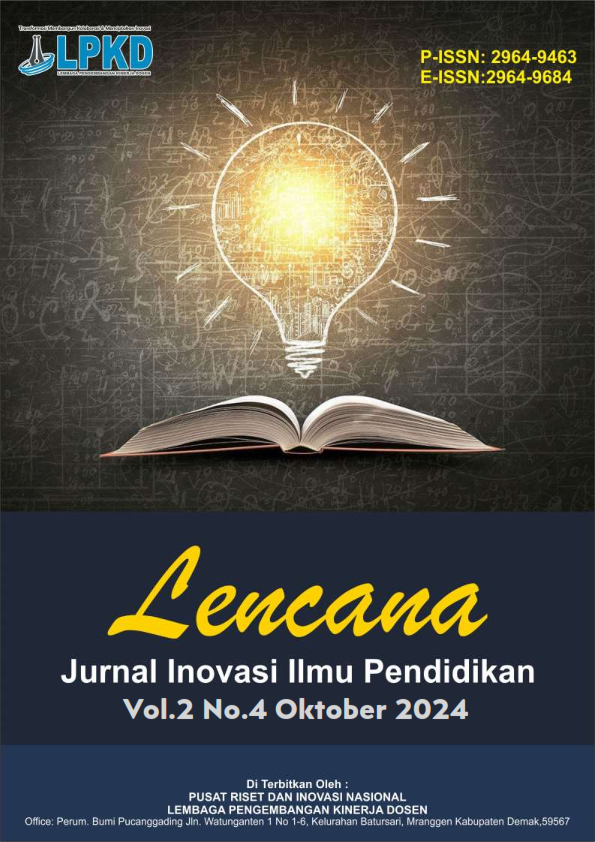Implementation Of The Teaching Factory Learning Model In Improving Students' Competence At State Vocational High School 1 Pacet
DOI:
https://doi.org/10.55606/lencana.v2i4.4039Keywords:
Learning Model, Teaching Factory, Product, Block Schedule, Job sheetAbstract
This research aims to obtain a fact-based picture in the form of data and information regarding the implementation of the Teaching Factory learning model at SMK Negeri 1 Pacet. Qualitative research methods are used to produce a comprehensive presentation based on findings in the field. The efforts made in education are on the learning processes and models used to achieve educational goals. Vocational High Schools (SMK) are schools that aim to prepare students who are skilled and ready to enter the world of work. To realize this goal, one of the flagship programs is the Teaching Factory. Teaching Factory is an effort to present the real world of work in an educational environment. The objectives of this Teaching Factory are (a) increasing the competency of students (b) increasing the entrepreneurial spirit of graduates (c) producing value-added products (goods/services) (d) expanding the scope of recruitment opportunities for vocational school graduates, and (e) increasing collaboration with the business/industrial world. KBased on the results of the research, it can be concluded that the implementation of Teaching Factory learning at SMK Negeri 1 Pacet on the Agribusiness Food Crops and Horticulture skills competency has gone well and can produce superior products and has been accepted as an industry standard by the market so that it can be used as a reference for other schools to implement Teaching Factory learning.
Downloads
References
Accessed on the Internet on December 26, 2022. Competencies according to the National Professional Certification Agency. Retrieved from https://kompetensi.info/kompetensi-kerja/apa-itu-kompetensi.html
Adhikary, P. K. (2005). Educational reform for linking skills development with employment in Nepal. In M. Singh (Ed.), Meeting basic learning needs in the informal sector integrating education and training for decent work, empowerment and citizenship (pp. 215-228). Hamburg, Germany: UNESCO Institute for Education.
Agung, K. (2014). Teaching factory: Entrepreneurship plans and values. Yogyakarta: Graha Ilmu.
Aini, S. N., & Sudira, P. (2015). The influence of learning strategies, learning styles, practice facilities, and media on the learning outcomes of patisseries vocational schools in Paperusila Gate. Journal of Education, 5(1), 88-102.
Ali, M. (2014). Understanding behavioral and social research. Jakarta: Bumi Aksara.
Arends. (2011). In Trianto. Designing an innovative-progressive learning model (4th ed., p. 41). Jakarta: Kencana.
Constitution No. 13 of 2003 concerning employment.
Creswell, J. W. (2014). Research design: Quantitative, qualitative, and mixed method approaches (4th ed.). SAGE Publications, Inc.
Directorate of Vocational School Development. (2017). Technical guidance for the implementation of the 2013 vocational high school curriculum (Dynamics of vocational high school curriculum development) (p. 40).
Dit. PSMK. (2012). Implementation guide, 2012, concerning assistance for entrepreneurship development for vocational schools/Teaching Industry. Ministry of Education and Culture. Jakarta.
Dit. PSMK. (2015). The teaching factory concept. Jakarta: Ministry of Education and Culture.
Fuad, A. (2022). Implementation of the teaching factory learning model to produce graduates that are compliant with the business and industrial world of students in the online business and marketing skills program at SMK N 6 Surakarta. Journal of Mechanical Engineering Education, 7(2).
GIZ. (2015). Teaching factory coaching program.
Hidayat, D. (2016). Teaching factory learning model to increase student competence in productive subjects. Journal of Educational Sciences, 17(4).
Joyce, B., & Weil, M. (2009). Models of teaching. America: A Person Education Company.
Lestari, et al. (2016). Effectiveness of implementing teaching factory for vocational high school (SMK) students in Solo Technopark. Journal of Mechanical Engineering Education, 3(4), 23.
Looy, D., Dierdonck, P., & Gemmel, P. (1998). Service management: An integrated approach. London: Financial Times Management.
Mulyasa, E. (2002). Curriculum development. Bandung: Rosdakarya Youth.
National Education Sikdik Law No. 20 of 2003.
President. (2016). Presidential Instruction Number 9, 2016, concerning revitalization of vocational schools in the context of improving the quality of Indonesian human resources.
Putu, S. (2016). XXI century TVET: Philosophy, theory, concepts and vocational learning strategies.
Robbins, S. P. (2007). Organizational behavior. Jakarta: PT Index.
Rojewski, J. W. (2009). A conceptual framework for technical and vocational education and training. In R. Maclean, D. Wilson, & C. Chinien (Eds.), International handbook of education for the changing world of work, bridging academic and vocational learning (pp. 20-21). Bonn: Springer.
Rusman. (2015). Integrated thematic learning theory, practice and assessment. Jakarta: PT Raja Grafindo Perdana.
Sanjaya, V. (2008). Process standard based learning strategy. Jakarta: Kencana Prenada Media Group.
St. Paul, Minneapolis, USA. Proceeding of the Fourth World Conference on Engineering Education, quoted by the Directorate of Vocational School Development.
Sugiyono. (2012). Combination research methods (Mixed Methods). Bandung: Alphabeta.
Sugiyono. (2018). Qualitative research methods. Bandung: Alphabeta.
U. Ibsal. (2016). Teaching factory, industry and entrepreneurship based school. Bandung: Teen Rosdakarya.
Wayan, D. J., Negeri Malang, U., & Kunci, K. (2020). A study on the implementation of vocational high school teaching factory in Malang city (Multi-case study). Journal of Mechanical Engineering Education, 7(2).
Downloads
Published
How to Cite
Issue
Section
License
Copyright (c) 2024 Lencana: Jurnal Inovasi Ilmu Pendidikan

This work is licensed under a Creative Commons Attribution-ShareAlike 4.0 International License.








